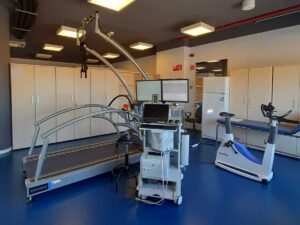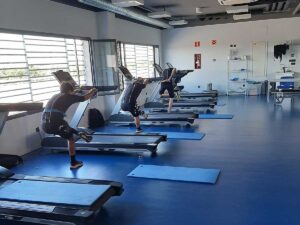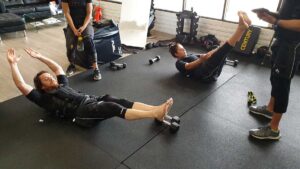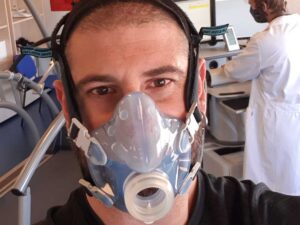Low back pain (LBP) is one of the leading orthopaedic diseases worldwide and affects almost everyone at least once in a lifetime [2,3]. In approximately 80% of cases, the cause of low back pain is not known and is declared nonspecific [4]. Physical exercise can be a good alternative to treat such ailment. This study confirmed that whole-body electrostimulation (WB-EMS) can produce positive effects on back pain [5]. Therefore, the use of WB-EMS with low subjective intensity seems to be an optimal option for unmotivated people or unable to exercise conventionally.
For this study, 30 patients with low back pain between 40-70 years were randomized in two groups: 15 patients with WB-EMS and 15 patients in an inactive control group. The WB-EMS group completed 12 weeks with a protocol of 1 session of 20 minutes per week performing gentle movements dedicated to low back pain.
The WB-EMS protocol was a bipolar electric current with a frequency of 85Hz, with a pulse width of 350us, a duty cycle of 6 seconds of electrical impulse and 4 seconds of rest once a week for 20 minutes. Participants completed one to three series with six easy moves with a minimum range of motion. The intensity of the WB-EMS was regulated by the Borg scale. CR10 (strong: 5 and very strong: 7). On the other hand, the control group continued their daily habits.
After 12 weeks of intervention, pain intensity decreased significantly in the WB-EMS group. However, this parameter remained unchanged in the CG. The strength of the trunk extenders and trunk flexors increased significantly in the WB-EMS group compared to the control group.
In the following table we can see the results obtained in each group.
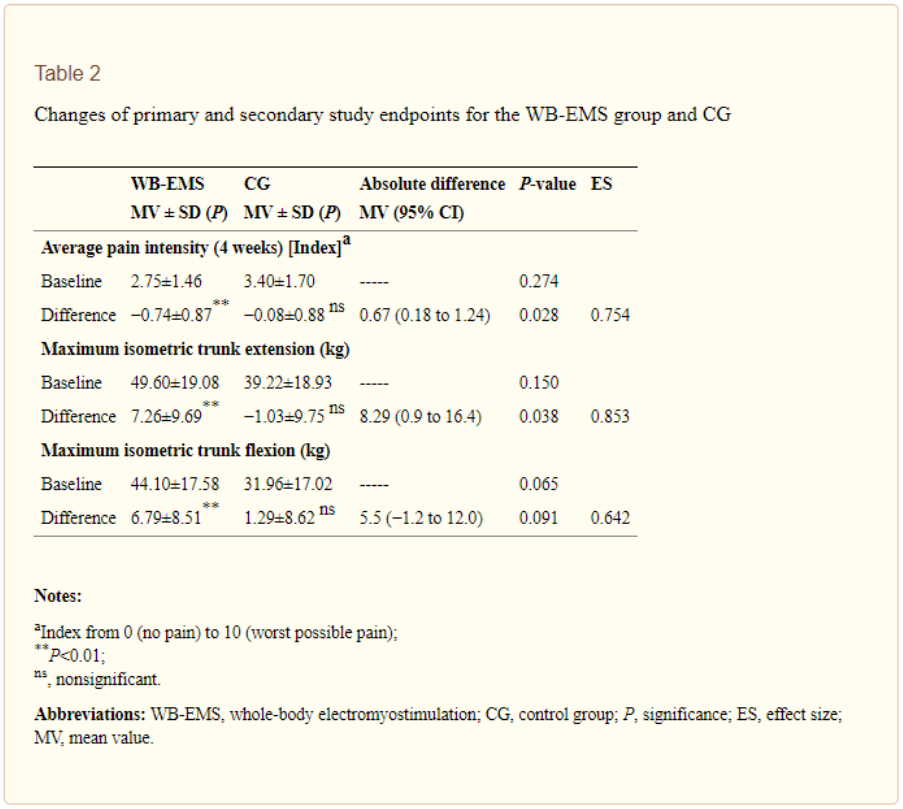
Also, it is an effective training method over time to reduce low back pain and increase strength in people with such pain.
After this promising comparison with a non-active control group, the research should be extended to include comparisons with active groups.
Bibliography
- Weissenfels A., Teschler M., Willert S., Hettchen M., Fröhlich M., Kleinöder H., Kohl M., Von Syengel., y Kemmler W. (2018). Effects of whole-body electromyostimulation on chronic nonspecific low back pain in adults: a randomized controlled study. J. Pain Res, 11 (1949-1957).
- GBD 2013 DALYs and HALE Collaborators, Murray CJ, Barber RM, Dalys GBD, et al. Global, regional, and national disability-adjusted life years (DALYs) for 306 diseases and injuries and healthy life expectancy (HALE) for 188 countries, 1990-2013: quantifying the epidemiological transition. Lancet. 2015;386(10009):2145–2191.
- Schmidt CO, Raspe H, Pfingsten M, et al. Back pain in the German adult population: prevalence, severity, and sociodemographic correlates in a multiregional survey. Spine. 2007;32(18):2005–2011.
- Abraham I, Killackey-Jones B. Lack of evidence-based research for idiopathic low back pain: the importance of a specific diagnosis. Arch Intern Med. 2002;162(13):1442–1444.
- Kemmler W, Weissenfels A, Bebenek M, et al. Effects of whole-body electromyostimulation on low back pain in people with chronic unspecific dorsal pain: a meta-analysis of individual patient data from randomized controlled WB-EMS trials. Evid Based Complement Alternat Med. 2017;2017:8480429.


